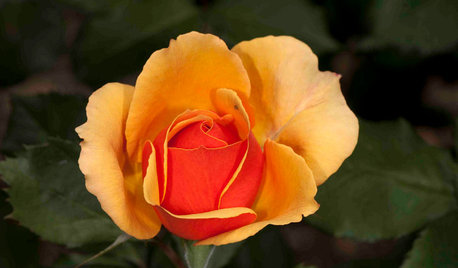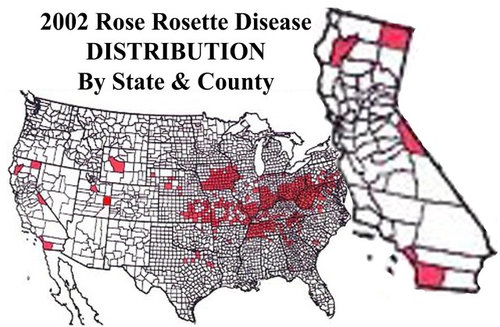Rose Rosette Disease
jerijen
6 years ago
Featured Answer
Sort by:Oldest
Comments (86)
stillanntn6b
6 years agostillanntn6b
6 years agoRelated Discussions
presence of Rose Rosette Disease on the climbing roses at the Ral
Comments (1)Oh, that is so sad to hear. I hate this stuff! I wonder if there will ever be a treatment for it, besides removal, that works....See MoreI think I have rose rosette disease on a rose.
Comments (17)The virus, unless it was in the graft, comes onto the foliage through mites. It works its way down the cane to the bud union, or roots in that case. No I just got rid of the whole thing, and am still looking for the smaller roots. I really dont think the hairy roots are that much to worry about, but its hard to get all the roots. In my case it was not in the grafted canes yet. If it is an old rose, you might want to replace soil anyway. The concern about roots might be that multiflora can grow from a small root, and many grafted roses in the NE and Canada are on multiflora. Every body is trying to go own root as much as possible because of the infection in MF....See Moreevaluation-of-rose-germplasm-for-resistance-to-rose-rosette-disease-a
Comments (6)The link above worked for me. When I find a link that does not work, I often can find the article by putting the title in quotes and putting it into Google. In this case this results in: https://www.google.com/search?num=100&newwindow=1&source=hp&ei=FNPfWq2vI4fusQW-h72QBA&q=%22evaluation-of-rose-germplasm-for-resistance-to-rose-rosette-disease-a%22&oq=%22evaluation-of-rose-germplasm-for-resistance-to-rose-rosette-disease-a%22&gs_l=psy-ab.12...1664.16166.0.18919.4.3.0.0.0.0.127.317.1j2.3.0....0...1.1j2.64.psy-ab..1.1.126.0..35i39k1.0.4DcrZxeltkQ I have a copy of the thesis, but it is copyrighted so I cannot post it. If you have a specific question about it, I can answer the question by putting small sections in quotes. "Table of contents: Chapter 1 INTRODUCTION : : : : : : : : : : : : : : : : : : : : : : : : : : : : : : page 1 - 22 2 SCREENING OF ROSA GERMPLASM FOR RESISTANCE TO ROSE ROSETTE DISEASE UNDER FIELD CONDITIONS : : : page 23 - 45 3 GRAFT AND MECHANICAL TRANSMISSION STUDIES OF ROSE ROSETTE VIRUS : : : : : : : : : : : : : : : : : : : : : : : : : page 46 - 54 4 BIOLOGICAL CONTROL OF PHYLLOCOPTES FRUCTIPHILUS (ACARI: ERIOPHYIDAE) USING PREDATORY MITES FROM THE FAMILY PHYTOSEIIDAE (ACARINA: MESOSTIGMATA) : : : : : : : : : : : : : : : : : : : : pages 55 - 69 Appendix A WEEKS ROSES LETTER TO CUSTOMERS : : : : : : : : : : : : page 70 B ENDPOINT RT-PCR PROTOCOL TO DETECT ROSE ROSETTE EMARAVIRUS : : : : : : : : : : : : : : : : : : : : : : : : page 71 -72 LIST OF TABLES 2.1 Genotypes in this study that have existing resistance data : : : : : page 26 2.2 Results from resistance screening for rose rosette disease, including the number of plants infected and number planted in the field. : : : page 32 -38 2.3 Ordinary run analysis (Madden et al. 1982) : : : : : : : : : : : : : page 41 B.1 Primers used in two-step endpoint RT-PCR protocol : : : : : : : : page 73"...See MoreRose Rosette Disease: A Threat to Kentucky Roses
Comments (0)See: [https://kentuckypestnews.wordpress.com/2019/08/20/rose-rosette-disease-a-threat-to-kentucky-roses/?ct=t(RSS_EMAIL_CAMPAIGN](https://kentuckypestnews.wordpress.com/2019/08/20/rose-rosette-disease-a-threat-to-kentucky-roses/?ct=t(RSS_EMAIL_CAMPAIGN)...See Morejerijen
6 years agostillanntn6b
6 years agokittymoonbeam
6 years agoroseseek
6 years agostillanntn6b
6 years agoportlandmysteryrose
6 years agoshebabee
6 years agonippstress - zone 5 Nebraska
6 years agoingrid_vc so. CA zone 9
6 years agoVaporvac Z6-OhioRiverValley
6 years agoportlandmysteryrose
6 years agohenry_kuska
6 years agoroseseek
6 years agostillanntn6b
6 years agojerijen
6 years agohenry_kuska
6 years agostillanntn6b
6 years agohenry_kuska
6 years agolast modified: 6 years agohenry_kuska
6 years agohenry_kuska
6 years agohenry_kuska
6 years agoroseseek
6 years agoMiGreenThumb (Z5b S.Michigan/Sunset 41) Elevation: 1091 feet
6 years agolast modified: 6 years agoerasmus_gw
6 years agojerijen
6 years agojerijen
6 years agostillanntn6b
6 years agojerijen
6 years agohenry_kuska
6 years agoBuford_NE_GA_7A
6 years agoalameda/zone 8/East Texas
5 years agoroseseek
5 years agoClaire8WA
5 years agoalameda/zone 8/East Texas
5 years agojerijen
5 years agojerijen
5 years agoalameda/zone 8/East Texas
5 years agoroseseek
5 years agojerijen
5 years agoPainter Man
5 years agoLynn-in-TX-Z8b- Austin Area/Hill Country
5 years agoroseseek
5 years agomad_gallica (z5 Eastern NY)
5 years agoroseseek
5 years agoPainter Man
5 years ago
Related Stories

GARDENING GUIDESGreat Design Plant: Knock Out Roses
As glorious as their high-maintenance kin for a fraction of the work, Knock Out roses make even beginners look like garden stars
Full Story
GARDENING GUIDESWhat Kind of Roses Should You Grow?
Want to add the beauty of roses to your garden? Find out which ones, from old-fashioned to modern, are right for you
Full Story
GARDENING GUIDESLearn the Secret to Bigger and Better Roses
Grow beautiful roses using both ordinary and unusual soil amendments
Full Story
GARDENING GUIDES5 Sweet to Spirited Pink Roses for an Enchanting Garden
Whether you go demure or daring, there's a pink rose here to make you flush with garden pride
Full Story
GARDENING GUIDESRoses: Crowning Touch of Gardens
Whether you're the Miss or Mister America of gardening or take a hands-off approach, roses can be a winning addition to your landscape
Full Story
GARDENING GUIDESGreat Design Plant: Rosa Banksiae a Low-Maintenance Beauty
This thornless, disease- and insect-resistant rose brings showers of white or yellow flowers to the spring garden
Full Story
GARDENING GUIDES6 Wonderfully Easy Roses for Any Gardener
Look like an expert even if you're just starting out, with these low-maintenance gems of the rose world
Full Story
SPRING GARDENINGHow to Grow a Rose Garden in Pots
Everything can come up roses, even without a plot of soil in sight. This step-by-step guide to growing roses in containers shows you how
Full Story
SPRING GARDENING5 Exotic Rose Colors for a Beautifully Different Garden
Give red a rest. Let these daring hues take the spotlight instead for a rose garden that turns heads
Full Story








jbriekstins